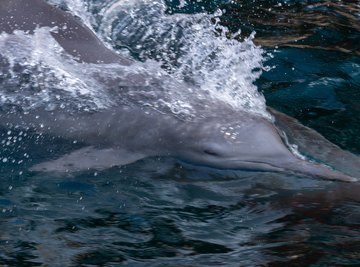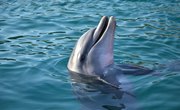
Most people find dolphins engaging, sociable, funny and clever. They are also extremely efficient hunters, feeding on everything from tiny shrimp to great white sharks. The dolphin diet depends on its type and habitat, though most dolphins eat fish, squid and crustaceans. Dolphins have several methods for gathering the large amounts of food they need each day.
Dolphins
Though dolphins may look like enormous fish, they are marine mammals. Unlike fish which lay eggs and can breathe underwater using their gills, dolphins bear and nurse live young and must come to the water’s surface to fill their lungs with air. Dolphins can remain under water for extended periods of time and have been known to dive to depths of over 1,000 feet. Dolphins come in 32 types, including the bottlenose dolphin, humpbacked dolphin, spotted dolphin, striped dolphin and the misnamed killer whale or orca. Except for the giant orca (which can weigh up to 1,200 pounds and be 27 feet long), most dolphins are 6 12 feet long.
Diet
Dolphins eat a wide variety of sea creatures, including fish, crustaceans and squid, depending on what is available to them in their environment. Open water dolphins eat mostly squid and fish, while dolphins living along the coast eat bottom-dwelling creatures and fish. Though they have teeth, dolphins swallow their prey without chewing. Smaller fish are swallowed whole, while larger fish are either shaken to bits or rubbed against something to break them apart. An adult dolphin will eat about 5 percent of its body weight in food every day. This means that an average-sized dolphin (about 385 pounds) will eat almost 20 pounds of fish, squid and shrimp a day. A similar-sized nursing mother will consume 30 pounds of food each day. Unlike the majority of dolphin types, the orca eats mammals and birds as well as fish, including seals, walruses, sea lions, penguins, whales and sharks. Though these huge dolphins sound and look dangerous, they are usually the most-loved performers at marine parks, being highly intelligent and sociable to humans.
Hunting
Dolphins use several strategies to obtain food, depending on their habitat. Dolphins living near the shore may band together to herd and trap fish between them and underwater rocks. Dolphins living in the open water may ring a school of fish, picking off the nearest fish and dashing through the circular trap to scoop up the centermost fish. Some dolphins dive down to 1,600 feet to catch large deep-sea fish. Dolphins will also follow fishing boats and floating fish processing plants to feed on any fish tossed out.
Nursing Calves
For the first three months of its life a dolphin calf lives on its mother’s milk alone. Over one-third of this rich liquid is fat, which enables the slender calf to quickly put on an insulating layer of blubber. At about three months, the calf begins to eat fish but still continues to nurse for up to a year and a half. Both day and night, the calf suckles three to eight times an hour, but for only a few seconds at a time. Calves remain with their mothers for up to three years.
References
About the Author
A freelance writer for more than 30 years, D.M. Gutierrez has had nonfiction, fiction and poetry published in women's, mystery, academic, children's, disability and teen print publications and websites including "Psychological Reports" and "Highlights for Children." She has an advanced degree in psychology from the University of California at Davis.
